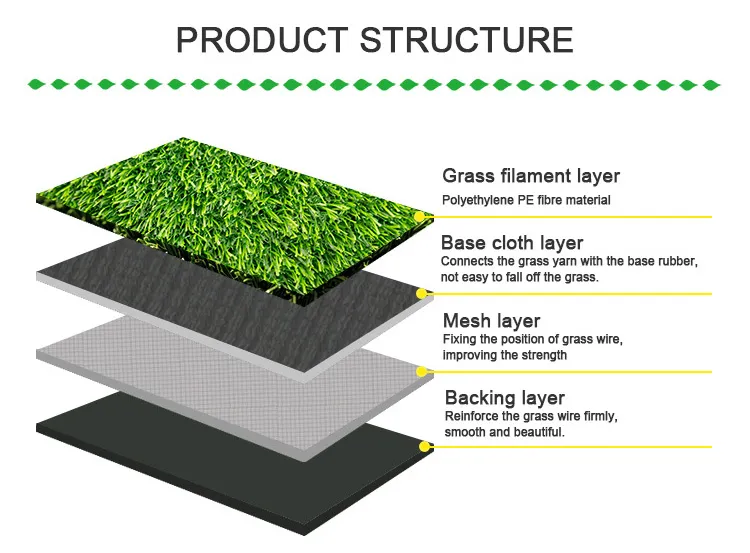
- Afrikaans
- Arabic
- Belarusian
- Bengali
- Czech
- Danish
- Dutch
- English
- Esperanto
- Estonian
- Finnish
- French
- German
- Greek
- Hindi
- Hungarian
- Icelandic
- Indonesian
- irish
- Italian
- Japanese
- kazakh
- Rwandese
- Korean
- Kyrgyz
- Lao
- Latin
- Latvian
- Malay
- Mongolian
- Myanmar
- Norwegian
- Persian
- Polish
- Portuguese
- Romanian
- Russian
- Serbian
- Spanish
- Swedish
- Tagalog
- Tajik
- Thai
- Turkish
- Turkmen
- Ukrainian
- Urdu
- Uighur
- Uzbek
- Vietnamese
artificial grass used on sports fields
Dec . 13, 2024 01:01 Back to list
The Rise of Artificial Grass in Sports Fields
Artificial grass, often referred to as synthetic turf, has become an increasingly popular choice for sports fields across the globe. As athletic facilities look for ways to enhance performance, maintainability, and environmental sustainability, the advantages of artificial grass are becoming more apparent. This article explores the benefits and considerations of using artificial grass in sports fields, shedding light on why it has gained significant traction in recent years.
The Rise of Artificial Grass in Sports Fields
Another significant benefit of artificial grass is its consistent playing surface. Natural grass can be unpredictable, depending on weather conditions and field wear. Rain can create muddy patches, while dry conditions can lead to hard, uneven ground. On the other hand, artificial turf provides a reliable and consistent playing experience, regardless of the weather. This consistency can lead to improved performance and safety for athletes. The even surface reduces the risk of injury associated with uneven natural fields, making it an attractive option for schools and sports organizations.
artificial grass used on sports fields

In addition to durability and consistency, artificial grass offers environmental benefits. The maintenance of natural grass typically requires vast amounts of water, pesticides, and fertilizers, which can have negative effects on local ecosystems. In contrast, synthetic turf does not need irrigation, reducing water usage significantly. Furthermore, modern artificial grass is often made from recyclable materials, making it a more sustainable option than in the past. Some manufacturers have even developed systems for draining rainwater effectively, further benefiting the environment.
While the benefits of artificial grass are numerous, there are considerations and potential downsides to be aware of. One concern is the heat retention of synthetic turf, which can become significantly hotter than natural grass under direct sunlight. This can impact the comfort and safety of athletes, especially during warm weather. However, advancements in turf technology, such as adding cooling technologies or using specialized infill, have addressed some of these concerns.
Another consideration is the initial investment required for installing artificial grass. Although long-term maintenance costs may be lower, the upfront costs can be substantial. It is essential for decision-makers to weigh these costs against the benefits and sustainability factors when considering a transition to synthetic turf.
In conclusion, the use of artificial grass in sports fields presents a host of advantages that can significantly improve athletic experiences. With its durability, low maintenance needs, consistent playing surface, and environmental considerations, artificial grass represents a forward-thinking solution for modern sports facilities. While there are challenges and initial costs associated with its installation, many organizations find that the long-term benefits far outweigh the drawbacks. As technology continues to advance, artificial grass will likely play an ever-increasing role in sports, enhancing performance and sustainability for years to come. The move towards synthetic turf reflects broader trends in sports and recreation, where innovation and environmental responsibility increasingly go hand in hand.
-
The Benefits of Artificial Turf for Indoors
NewsJul.15,2025
-
How Artificial Grass Suppliers Ensure Quality Products
NewsJul.15,2025
-
Artificial Grass and Pets: A Space for Relaxation
NewsJul.08,2025
-
Balcony & Outdoor Decoration with Artificial Grass
NewsJul.08,2025
-
Best Indoor Artificial Grass for Home
NewsJul.07,2025
-
Best Pet Turf for Dogs: Safe & Durable Artificial Grass Options
NewsJul.07,2025
Products categories









